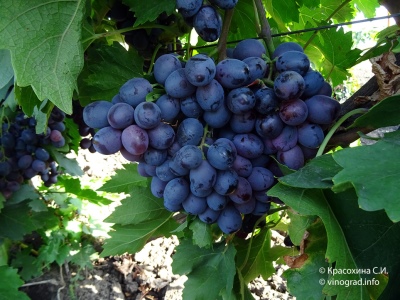
- Authors: Negrul A.M. and Zhuravel M.S., Central Asian station of VIR
- Appointment: dining room
- Berry color: black with prune bloom
- Taste: pleasant, harmonious
- With bones: Yes
- Ripening period: late
- Ripening period, days: 144
- Frost resistance, ° C: -18
- Bunch weight, g: 500
- Flower type: bisexual
The Pobeda variety is an excellent choice for winegrowers in the southern regions of the country, time-tested, not inferior in yield and external spectacularity to new grape varieties. Subject to agricultural practices, this valuable gift from Uzbekistan will delight Russian winegrowers for a long time to come.
Breeding history
The Pobeda variety was bred in the Central Asian branch of the All-Union Institute of Plant Industry in Tashkent in the middle of the 20th century. Breeders A. M. Negrul and M. S. Zhuravel crossed the Zabalkan grapes with Hamburg Muscat to create a hybrid. Initially, the Pobeda variety was zoned and distributed in Uzbekistan. Then the growing area was expanded, it is successfully cultivated in the southern regions of the country. According to its main properties and characteristics, it belongs to oriental table varieties.
Description
Root-viable and grafted table grape bushes are vigorous. They are distinguished by a beautiful, decorative appearance. This makes it possible to use it for landscaping gazebos, pergolas, arches, terraces. The leaf plate is of medium size, strongly dissected, five-lobed, smooth, light green, with bristly pubescence at the bottom of the leaf. Pale pink spots may appear. Short internodes are a characteristic feature. Young shoots are green, slightly reddish on the sunny side, covered with sparse hairs. Ripe vine is brown.
Fruiting of the variety begins at 3-4 years of growth. Shoots ripen well in a season.
Victory fruits are good both fresh and for drying, suitable for winter storage. The main properties of the variety:
weak frost resistance:
resistance to diseases is high, to pests - average, it is affected by fungal diseases;
high transportability and marketability;
vigor;
the possibility of long-term storage.
Ripening period
The growing season is 144 days. In the southern regions, grapes ripen by mid-September.
Bunches
Large, long, rather loose, cylindrical bunches, medium density. Weight 300-500 g. The legs of the brushes become woody at the point of attachment to the shoot, the pea is minimal.
Berries
Very large, black, 37 mm long, 26 mm wide, plum-shaped, slightly elongated, covered with a thick edible skin, with a pronounced, blue waxy bloom - pruin. The average weight of a berry is 14-16 g, sometimes up to 25 g. The pulp is juicy, fleshy, contains 2-3 seeds. But there may be fruits without seeds.
Taste
Ripe fruits have sugar content up to 26%, acidity 6.3 g / dm3. This combination gives harmony to the sweet and sour, refreshing taste. Tasters highly appreciate the taste of Pobeda grapes and the most presentable appearance in comparison with other table grape varieties.
Yield
The plant forms an average of 40 to 50% of fruitful shoots, the number of clusters per shoot is 1.1. In the most suitable climatic conditions, the yield reaches 11-15 tons per hectare or 10-12 kg per bush.


Growing features
Victory is demanding on the cultivation technique and soil moisture. In Central Asia, the variety is cultivated as an irrigated crop with shelter in winter. Apply a large fan formation on the trellis installed vertically. Do not water the grapes when ripe, in order to avoid damage to the berries and the appearance of mold on them.
Sandy loam and loam are considered suitable soils for cultivation. The acidity should be:
slightly acidic (pH 5.5-6.5);
neutral (pH 6.5-7);
slightly alkaline (7-7.5).
The plant is demanding on light, cannot stand the proximity of groundwater.
Landing
Seedlings of Victory are planted, observing the rules common to most varieties: in a sunny, elevated place protected from cold winds. Taking into account the rapid growth of bushes and the feeding area of one plant, the distance between them should be left from 1.5 to 2 m. Trellis are immediately arranged as a support for the vine.

Pollination
The flowers are bisexual, no special pollination techniques are required. It can act as a pollinator for varieties with a female type of flowering.
Pruning
The peculiarities of the variety make it possible to prune 10-12 eyes on one fruit shoot. In the spring, they break off barren shoots, leaving 4-8 well-ripened vines. Fruit-bearing buds are found to a large extent on the upper part of the shoot; therefore, long pruning is used. When the bushes are overloaded, the grapes become smaller and ripen unevenly. In order to avoid this, they carry out a double fragment of shoots and pinching.



Frost resistance and the need for shelter
The low winter hardiness of the variety requires a thorough cover for the winter.

Diseases and pests
The cause of vineyard diseases can be illiterate care: pruning carried out at the wrong time, untimely watering or excessive soil moisture, lack of prevention of fungal diseases, which are common for the Pobeda variety. Excessive summer rainfall and sudden changes in temperature can trigger fungal growth. To combat it, fungicides are used, observing the dosage and rules for processing plants.

If a grape is exposed to any disease or insect, this always affects its appearance.
Storage
The grapes are great for winter storage.The qualities of the variety allow the berries not to wither for a long period of time, maintaining a presentable appearance and properties of a fresh harvest for a long time. Hydrophilic colloids (polysaccharides, pectins, tannins) present in fruits help to retain the required amount of water in the fruits.
Drying Pobeda grapes produces large-berry raisins that look like prunes.











































































